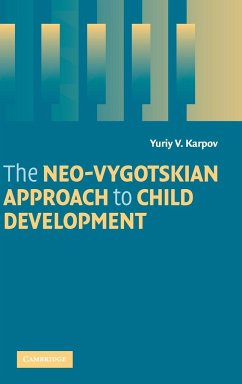Short description/annotation
The first time the innovative neo-Vygotskian approach to child development is introduced to English-speaking readers.
Main description
For the first time, the neo-Vygotskian approach to child development is introduced to English-speaking readers. Russian followers of Vygotsky have elaborated his ideas into a theory that integrates cognitive, motivational, and social aspects of child development with an emphasis on the role of children's activity as mediated by adults in their development. This theory has become the basis for an innovative analysis of periods in child development and of the mechanism of children's transitions from one period to the next. In this book, the discussion of the neo-Vygotskians' approach to child development is supported by a review of their empirical data, much of which has never before been available to English-speaking readers. The discussion is also supported by a review of recent empirical findings of Western researchers, which are highly consistent with the neo-Vygotskian analysis of child development.
Table of contents:
Introduction: the problem of determinants and mechanisms of child development; 1. Vygotsky's approach to child development; 2. The neo-Vygotskian elaboration of Vygotsky's approach to child development; 3. First year of life: emotional interactions with caregivers as the leading activity of infants; 4. Second and third years of life: object-centered joint activity with adults as the leading activity of toddlers; 5. Three to six-year-olds: sociodramatic play as the leading activity during the period of early childhood; 6. The period of middle childhood: learning at school as children's leading activity; 7. The period of adolescence: interactions with peers as the leading activity of adolescents; 8. Conclusion - the neo-Vygotskian approach to child development: accomplishments and shortcomings.
The first time the innovative neo-Vygotskian approach to child development is introduced to English-speaking readers.
Main description
For the first time, the neo-Vygotskian approach to child development is introduced to English-speaking readers. Russian followers of Vygotsky have elaborated his ideas into a theory that integrates cognitive, motivational, and social aspects of child development with an emphasis on the role of children's activity as mediated by adults in their development. This theory has become the basis for an innovative analysis of periods in child development and of the mechanism of children's transitions from one period to the next. In this book, the discussion of the neo-Vygotskians' approach to child development is supported by a review of their empirical data, much of which has never before been available to English-speaking readers. The discussion is also supported by a review of recent empirical findings of Western researchers, which are highly consistent with the neo-Vygotskian analysis of child development.
Table of contents:
Introduction: the problem of determinants and mechanisms of child development; 1. Vygotsky's approach to child development; 2. The neo-Vygotskian elaboration of Vygotsky's approach to child development; 3. First year of life: emotional interactions with caregivers as the leading activity of infants; 4. Second and third years of life: object-centered joint activity with adults as the leading activity of toddlers; 5. Three to six-year-olds: sociodramatic play as the leading activity during the period of early childhood; 6. The period of middle childhood: learning at school as children's leading activity; 7. The period of adolescence: interactions with peers as the leading activity of adolescents; 8. Conclusion - the neo-Vygotskian approach to child development: accomplishments and shortcomings.


